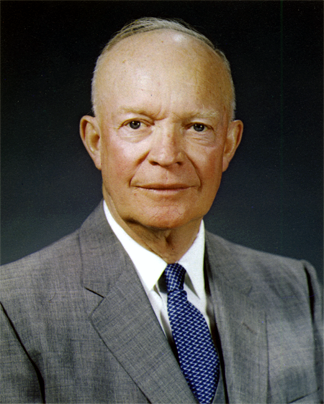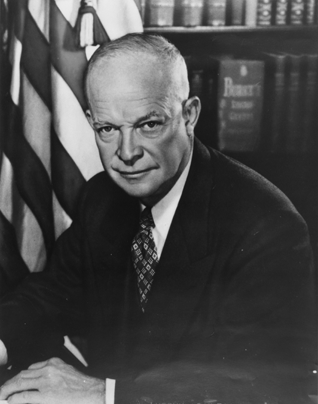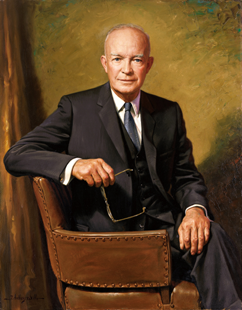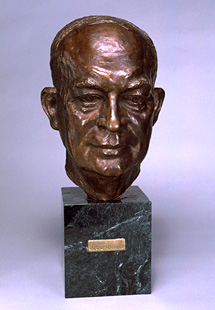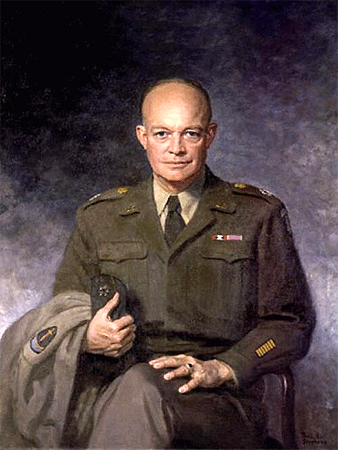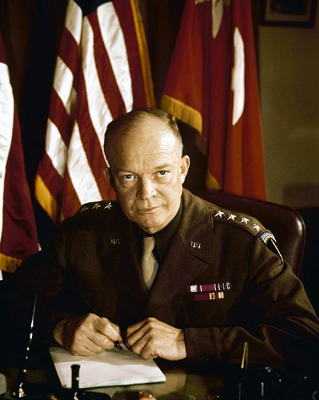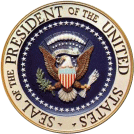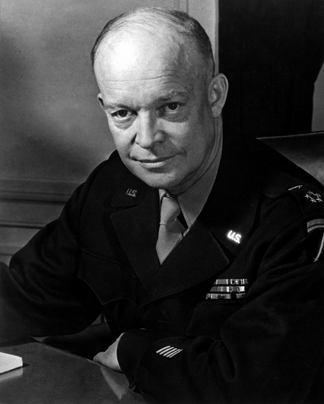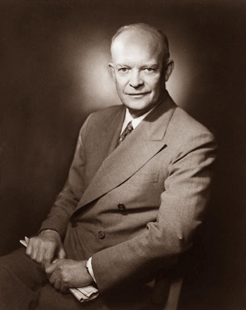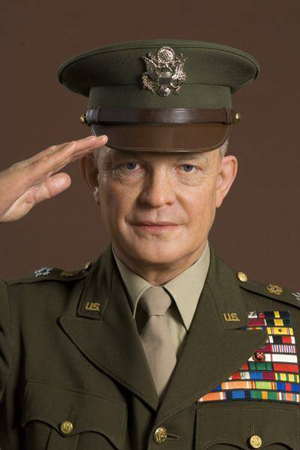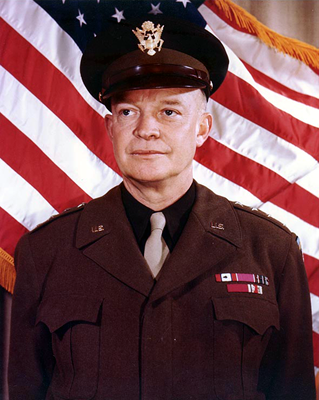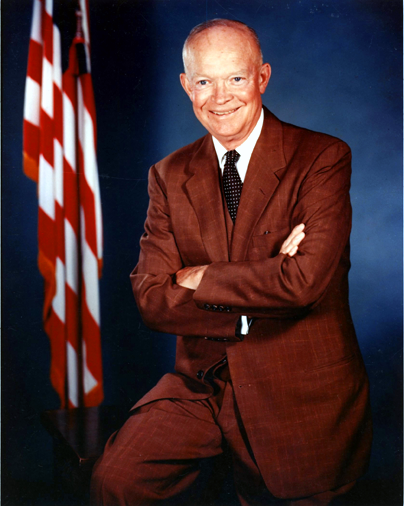|
DWIGHT D. EISENHOWER |
|
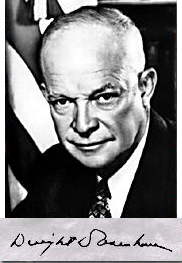
THE 34TH PRESIDENT OF
THE UNITED STATES OF AMERICA
(1953-1961)
EISENHOWER, Dwight David "Ike"
(1890–1969), American military leader, whose great popularity as Allied supreme commander during World War II secured him election as the 34th president of the U.S. (1953–61).He was given the name David Dwight Eisenhower, (named after his father David,) at birth. However, his family found that there were too many David's in the family and reversed the order of his names. He ended up being called "Little Ike." Camp David is named for his son, whose name was David.
Early Life.
Born in Denison, Tex., on Oct. 14, 1890, Eisenhower grew up on a small farm in Abilene, Kans. His devout and industrious parents, David (1863–1942) and Ida (1862–1946), raised six sons. Interested in sports and history, young Dwight went to West Point for the free education. Eisenhower was commissioned an infantry officer upon graduation in 1915 and married Mamie Doud (1896–1979) the following year. They had two sons, one of whom died in childhood.
Eisenhower did not see combat duty during World War I, but he was decorated and promoted to lieutenant colonel for his administrative skills in commanding a tank corps training center. In the interwar years, he was recognized as a promising leader at the Command and General Staff school and served as an industrial mobilization planner and as aide to the army chief of staff and later military adviser to the Philippines, Gen. Douglas MacArthur.
Service in World War II.
During training exercises in 1940–41, Eisenhower won praise in several army staff positions, culminating in that of chief of staff of the Third Army; at the same time he was promoted to brigadier general. Called to the War Department as a Philippines expert a few days after the attacks on Pearl Harbor and the Philippines, he won further promotion to major general and was named chief of the newly organized Operations Division of the General Staff three months later. By this time the army’s top planner, he then prepared plans for the European theater of operations, and in June 1942 he was given command of U.S. forces in Europe by Army Chief of Staff George C. Marshall. Subsequently as Allied commander in the invasions of North Africa, Sicily, and Italy, he demonstrated outstanding skill in forging the allies into an effective fighting force and managing the large-scale operations.
Appointed supreme commander of the Allied Expeditionary Force for the invasion of France, Eisenhower, by then a full general, began his new assignment in January 1944. In the months prior to the invasion, on June 6, 1944, he supervised the preparation of air, sea, and land forces and all other strategic planning and made the crucial decision on the date of the assault. During the fighting that ensued until the end of the war in Europe, Eisenhower, who became General of the Army in December 1944, had the overall responsibility of strategic and administrative control of an Allied force that eventually numbered more than 4,500,000. Because it was strategically safer and logistically sounder, Eisenhower employed a broad-front strategy, requiring all his armies to advance more or less simultaneously. This caused disagreement with the British commander, Field Marshal Bernard Montgomery, who favored the risky single-thrust theory of concentrating the attack in one area. As supreme commander, Eisenhower prevailed, skillfully using his knowledge and experience combined with charm and tact to achieve success in his task, which involved not only fighting the Germans but also dealing with sometimes difficult allies and troublesome subordinates.
In the fall of 1945, Eisenhower became army chief of staff. During his tenure in that office—slightly more than two years—he had the dual role of demobilizing the wartime army while maintaining a suitable defense force. Although he accepted the presidency of Columbia University in 1948, he still served as a military adviser, and, some three years later, he returned to Europe as supreme commander for the North Atlantic Treaty Organization.
Eisenhower as President.
Although he had previously rejected numerous overtures from members of both parties to run for the presidency, Eisenhower yielded to the appeal of liberal Republicans in 1952. As a war hero of enormous popularity, he appealed to many Democrats as well, and he handily defeated Adlai Stevenson by more than 6.6 million votes. When he ran again in 1956, the margin was 9.5 million.
Domestic policy.
Although his cabinet featured prominent businessmen, and his own desire was for less government involvement in society and the economy, Eisenhower pursued a moderate course in domestic affairs to the evident satisfaction of most Americans. Throughout all but the first two years of his administration, his power was limited by the Democrats’ control of Congress. He did trim some government activities but also expanded the Social Security program, aid to education, and the Interstate Highway System. Nevertheless, in his farewell address, he returned to his concern about the dangers of big government with a strong warning against the "military-industrial complex." During his administration, critics pointed out his failure to oppose Senator Joseph McCarthy’s smear tactics against alleged subversives in government and his lack of support for the emerging civil rights movement. McCarthyism soon collapsed without presidential intervention, however, and Eisenhower did send federal troops to Little Rock, Ark., to enforce school integration in 1957.
Foreign policy.
As was natural for a man of his background, Eisenhower took particular interest in military and diplomatic affairs. This led him to invigorate the National Security Council, bring a quick end (July 27, 1953) to the stalemated war in Korea, and reduce the strength of the conventional forces. His emphasis on airpower, which meant nuclear weapons—a strategy of massive retaliation rather than response tailored to the specific situation—evoked strong dissent from army leaders. Despite temporary thaws, the cold war with the Soviet Union continued throughout his presidency. Eisenhower supported the strong moralistic, anti-Communist stance of his secretary of state, John Foster Dulles. Although Dulles talked of "going to the brink" of war to gain diplomatic ends, his rhetoric outstripped the administration’s actions. Eisenhower did not intervene militarily in Vietnam to save the French (1954) or in Eastern Europe to aid German and Hungarian revolts against Soviet domination (1953 and 1956). He did, however, dispatch a small expedition to Lebanon in 1958, and he built up alliances with Third World nations. Soviet threats, as well as such technological and psychological coups as the launching of Sputnik, the first artificial satellite, in October 1957, drew a typically cautious response from him. In the spring of 1960, his acceptance of responsibility for a U-2 plane’s spy flight over the USSR brought a temporary end to hopes for harmonious relations with the Soviet Union.
Retirement, death and funeral.
Eisenhower retired to the place where he and Mamie had spent much of their post-war time, a working farm adjacent to the battlefield at Gettysburg, Pennsylvania, only thirty miles from his ancestral home of York. In 1967, the Eisenhowers donated the farm to the National Park Service. In retirement, the former president did not completely retreat from political life; he spoke at the 1964 Republican National Convention and appeared with Barry Goldwater in a Republican campaign commercial from Gettysburg. However, his endorsement came somewhat reluctantly because Goldwater had attacked the former president as "a dime-store New Dealer".
In retirement, Eisenhower wrote several volumes of memoirs and enjoyed his hobbies of golf and painting. Both presidents John F. Kennedy and Lyndon B. Johnson consulted the still popular elder statesman.
On March 28, 1969, Eisenhower died in Washington, D.C. of congestive heart failure at Walter Reed Army Hospital. The following day his body was moved to the Washington National Cathedral's Bethlehem Chapel, where he lay in repose for 28 hours. On March 30, his body was brought by caisson to the United States Capitol, where he lay in state in the Capitol Rotunda. On March 31, Eisenhower's body was returned to the National Cathedral, where he was given an Episcopal Church funeral service. That evening, Eisenhower's body was placed onto a train en route to Abilene, Kansas. His body arrived on April 2, and was interred later that day in a small chapel on the grounds of the Eisenhower Presidential Library. Eisenhower is buried alongside his son Doud, who died at age 3 in 1921. His wife Mamie was buried next to him after her death in 1979.0
Richard Nixon, then President, spoke of Eisenhower,
"Some men are considered great because they lead great armies or they lead powerful nations. For eight years now, Dwight Eisenhower has neither commanded an army nor led a nation; and yet he remained through his final days the world's most admired and respected man, truly the first citizen of the world."
Tributes and memorials.
Eisenhower is remembered for his role in World War II, the creation of the Interstate Highway System and ending the Korean War.
The Interstate Highway System is officially known as the 'Dwight D. Eisenhower National System of Interstate and Defense Highways' in his honor. Commemorative signs reading "Eisenhower Interstate System" and bearing Eisenhower's permanent 5-star rank insignia were introduced in 1993 and are currently displayed throughout the Interstate System. Several highways are also named for him, including the Eisenhower Expressway (Interstate 290) near Chicago and the Eisenhower Tunnel on Interstate 70 west of Denver.
The British A4 class steam locomotive No. 4496 (renumbered 60008) Golden Shuttle was renamed Dwight D. Eisenhower in 1946. It is preserved at the National Railroad Museum in Green Bay, Wisconsin. USS Dwight D. Eisenhower, the second Nimitz-class supercarrier, was named in his honor.
Eisenhower College was a small, liberal arts college chartered in Seneca Falls, New York in 1965, with classes beginning in 1968. Financial problems forced the school to fall under the management of the Rochester Institute of Technology in 1979. Its last class graduated in 1983.
Eisenhower Hall, the cadet activities building at West Point, was completed in 1974. In 1983, the Eisenhower Monument was unveiled at West Point.
The Eisenhower Medical Center in Rancho Mirage, California was named after the President in 1971.
The Dwight D. Eisenhower Army Medical Center, located at Fort Gordon near Augusta, Georgia, was named in his honor.
In 1983, The Eisenhower Institute was founded in Washington, D.C., as a policy institute to advance Eisenhower's intellectual and leadership legacies.
In 1989, U.S. Ambassador Charles Price and British Prime Minister Margaret Thatcher dedicated a bronze statue of Eisenhower in Grosvenor Square, London. The statue is located in front of the current US Embassy, London and across from the former command center for the Allied Expeditionary Force during World War II, offices Eisenhower occupied during the war.
In 1999, the United States Congress created the Dwight D. Eisenhower Memorial Commission, to create an enduring national memorial in Washington, D.C.. In 2009, the commission chose the architect Frank Gehry to design the memorial. The memorial will stand near the National Mall on Maryland Avenue, SW across the street from the National Air and Space Museum.
On May 7, 2002, the Old Executive Office Building was officially renamed the Eisenhower Executive Office Building. This building is part of the White House Complex, and is west of the West Wing. It currently houses a number of executive offices, including ones for the Vice President and his or her spouse.
A county park in East Meadow, New York (Long Island) is named in his honor. Eisenhower State Park on Lake Texoma near his birthplace of Denison is named in his honor.
His birthplace is currently operated by the State of Texas as the Eisenhower Birthplace State Historic Site. Since 1980, the National Park Service has allowed visitors to the Eisenhower Farm adjacent to the Gettysburg Battlefield.
Many public high schools and middle schools in the U.S. are named after Eisenhower.
Mount Eisenhower was named in the Presidential Range of the White Mountains in New Hampshire.
The Eisenhower Golf Club at the United States Air Force Academy, a 36-hole facility featuring the Blue and Silver courses, which is ranked No. 1 among DoD courses, is named in his honor.
Eisenhower Park on Washington Square in Newport, Rhode Island, dedicated by President Eisenhower in 1960.
The 18th hole at Cherry Hills Country Club, near Denver, is named in his honor. Eisenhower was a longtime member of the club, which operated one of his favorite courses.
A loblolly pine, known as the "Eisenhower Pine", is located on the 17th hole, approximately 210 yards (192 m) from the Masters tee. President Dwight D. Eisenhower, an Augusta National member, hit the tree so many times that, at a 1956 club meeting, he proposed that it be cut down. Not wanting to offend the president, the club's chairman, Clifford Roberts, immediately adjourned the meeting rather than reject the request.
During a visit to Augusta National, then General Eisenhower returned from a walk through the woods on the eastern part of the grounds, and informed Clifford Roberts that he had found a perfect place to build a dam if the club would like a fish pond. Ike's Pond was built and named, and the dam is located just where Eisenhower said it should be.
